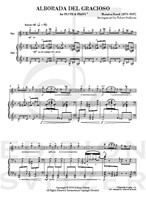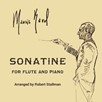
Alborada Del Gracioso
Composer: Maurice Ravel
Instrument: Flute and Piano
Level: Advanced
Published: 2016
Price: €22.00
Item details
-
Description +
-
Arranged by Robert Stallman
Duration: 6 min.
...The Alborada is one of five pieces for piano that form the suite Miroirs (“Mirrors”), written by Ravel in 1905 and first performed in Paris in early 1906 by his virtuoso pianist friend Ricardo Vines. Each of these pieces is a sonic image of real life experiences, and the Alborada del Gracioso (“Dawn of the Jester”) is quite likely a satiric reflection of the composer himself in his more flippant and sardonic moods...
-
-
Instrumentation +
-
Flute and Piano
-
-
About the composer +
-
Joseph Maurice Ravel (7 March 1875 – 28 December 1937) was a French composer, pianist and conductor. He is often associated with impressionism along with his elder contemporary Claude Debussy, although both composers rejected the term. In the 1920s and '30s Ravel was internationally regarded as France's greatest living composer.
Born to a music-loving family, Ravel attended France's premier music college, the Paris Conservatoire; he was not well regarded by its conservative establishment, whose biased treatment of him caused a scandal. After leaving the conservatoire Ravel found his own way as a composer, developing a style of great clarity, incorporating elements of baroque, neoclassicism and, in his later works, jazz. He liked to experiment with musical form, as in his best-known work, Boléro (1928), in which repetition takes the place of development. He made some orchestral arrangements of other composers' music, of which his 1922 version of Mussorgsky's Pictures at an Exhibition is the best known.
As a slow and painstaking worker, Ravel composed fewer pieces than many of his contemporaries. Among his works to enter the repertoire are pieces for piano, chamber music, two piano concertos, ballet music, two operas, and eight song cycles; he wrote no symphonies or religious works. Many of his works exist in two versions: a first, piano score and a later orchestration. Some of his piano music, such as Gaspard de la nuit (1908), is exceptionally difficult to play, and his complex orchestral works such as Daphnis et Chloé (1912) require skilful balance in performance.
Ravel was among the first composers to recognise the potential of recording to bring their music to a wider public. From the 1920s, despite limited technique as a pianist or conductor, he took part in recordings of several of his works; others were made under his supervision.
-
-
Reviews +
-
Traversiéres MAGAZINE No 124 (2018)
Maurice Ravel: Alborada del Gracioso, arrangement Robert Stallmann
Robert Stallman nous propose une excitante transcription de la sublime musique de Maurice Ravel, une gageure exaltante ! Edition soignée par Jean-Luc Abras.
Robert Stallman offers us an exciting transcription of Maurice Ravel's sublime music, an exhilarating challenge! Neat edition by Jean-Luc Abras.
-
-
Credits +
-
Front Cover graphics and layout: Gaia Gomes
Photo of Robert Stallman: Lisa Kohler
Engraving: Ary Golomb
Drawing of Ravel (artist unknown), courtesy of Robert Stallman
Printed in Copenhagen, Denmark
Copyright © Edition SVITZER
www.editionsvitzer.com
-









